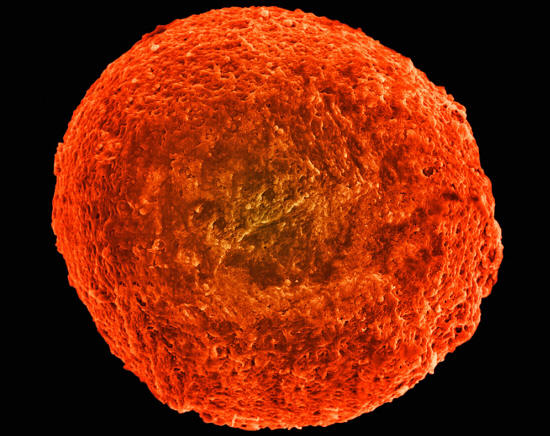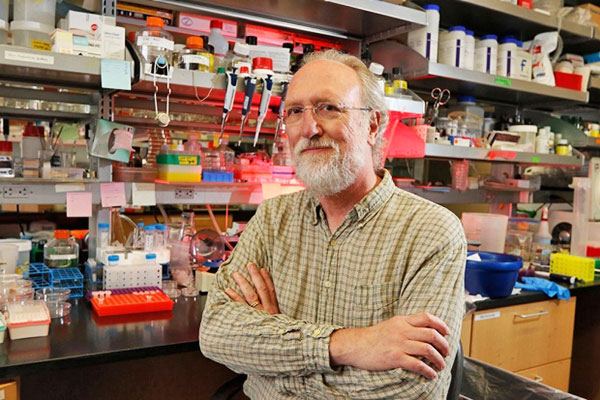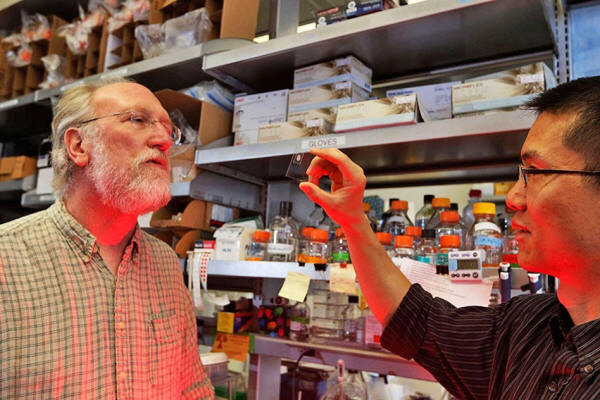|
To some of us, it happens
more than once. And scientists at Stanford University have now been
able to figure out (Apoptosis
Propagates through the Cytoplasm as Trigger Waves) just
how fast it happens on a cellular level.
The cytoplasm was picked as its full of proteins, which were visible as bright green globs. The researchers then placed an extract from a cell that had recently undergone programmed cell death at the far end of the tube and measured how quickly it spread.
The cells basically
self-destructed, started by a "trigger wave" which then spread at
roughly at 2mm an hour or 30 micro-centimeters a minute.
Interestingly, according to New Scientist, the self-destruction part occurred much faster than the extract itself moved.
Look at your hands and you're actually looking at the result of programmed cell death that happened long ago in the womb.
Towards the end of the
first trimester, the cells that hold the hand together separate -
otherwise, we'd be web-handed. It can also occur in cancer (Programmed
Cell Death and Cancer).
...Cell Death Spreads through Perpetuating Waves
by Hanae Armitage
James Ferrell found that trigger waves help guide
a
widespread form of cell death known as apoptosis.
death is akin to falling dominoes: One death-inducing molecule activates another, and so on, until the entire cell is shut down, a new Stanford study finds.
A new study (Apoptosis Propagates through the Cytoplasm as Trigger Waves) out of the Stanford University School of Medicine has found that this phenomenon guides one of the most well-known and widespread forms of cell death:
It's not the first time trigger waves have been identified in the microcosms of life.
The cell cycle, a cornerstone of cell biology in which cells divide to make new cells, regulates production via trigger waves, too. So do neuronal action potentials, which allow neurons to pass signals via electrical impulse.
And it likely doesn't end there.
One of the better-understood forms of cell death, apoptosis still manages to mystify scientists.
The study was published in Science Aug. 10.
James Ferrell is the senior author. Postdoctoral scholar Xianrui Cheng, PhD, is the lead author.
One domino collapses on another and triggers that domino to topple onto the next. The threshold is the force necessary to completely knock the tile over; a domino just shy of its threshold would teeter and rock back into a vertical position, whereas one that's reached the threshold would fall.
Trigger waves in an apoptotic cell are governed by that same phenomenon. Once cell death is initiated, by way of disease or something else, specific killer proteins in the cell, called caspases, activate.
These proteins then float
to other caspases and activate them; those follow suit until the
entire cell has to pack it in.
look at
a slide containing a frog egg.
To see how death takes over a single cell, Cheng and Ferrell used Xenopus frog eggs.
One egg is a single cell,
and as cells go, these are enormous, making them a prime candidate
to observe how death spreads from one end of the cell to the other,
which can be done with the naked eye.
By using a fluorescent
technique linked to the activation of apoptosis, Ferrell and Cheng
could watch as the bright green glow moved its way down the tube at
a constant speed, indicating that apoptosis was spreading via
trigger waves, as opposed to some other more rudimentary mechanism,
such as diffusion, which slows down as it moves.
Turning to fluorescence microscopy here proved more difficult, as intact frog eggs are quite opaque.
However, Cheng and Ferrell noticed that when frog eggs die, a sort of ripple of pigmentation occurs at the egg's surface.
The scientists saw that during death, a dark ripple moved like a curved line across the egg at a constant speed from one side to the other. The speed of this surface wave, which was constant and did not slow down, tipped them off to trigger waves here too.
So to further confirm, they analyzed individual dying eggs:
Viruses spread from cell to cell through trigger waves, so it makes sense that our initial line of immune defense might employ the same tactic.
|




